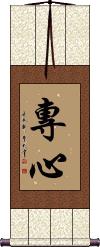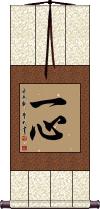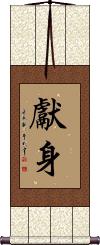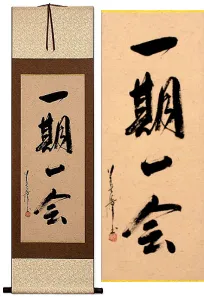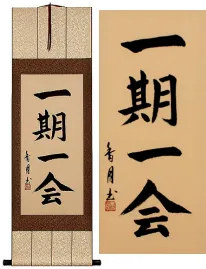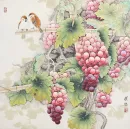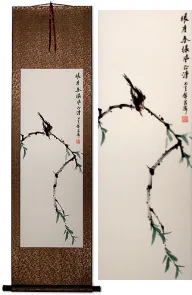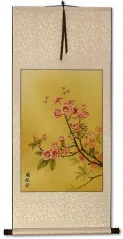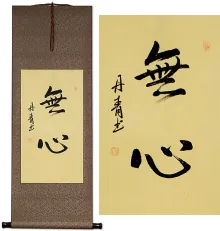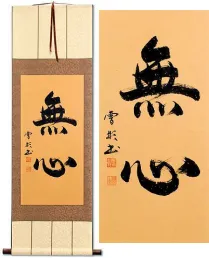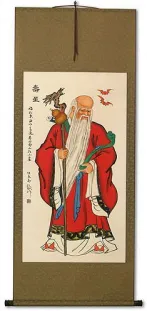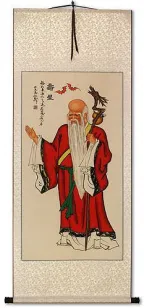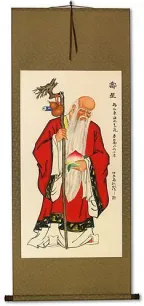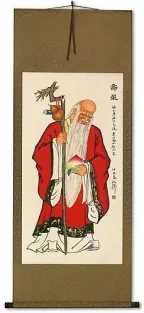Many custom options...
And formats...

The name One Heart in Chinese / Japanese...
Buy an One Heart calligraphy wall scroll here!
Personalize your custom “One Heart” project by clicking the button next to your favorite “One Heart” title below...
Devotion / Dedication / Attentive / Focused
專心 makes a word that means “paying attention with your heart.”
It's often translated as “dedication,” as in “be absorbed in” or “concentrate one's efforts.” It's also used to mean “with the single mind,” “whole-heartedly,” “paying attention,” “undivided attention,” “concentration (-ed),” “engrossed,” “devotionally (listening/watching),” and/or “attentive.”
The first character means “for a particular person, occasion, or purpose,” “focused on one single thing,” “concentrated,” and sometimes, “special.”
The second character means “heart” or “mind” by itself.
My favorite translation, which comes from the Oxford Advanced Chinese/English Dictionary, is, “wholehearted devotion.”
If it seems like the meaning of this word is quite open, you are correct. The context in which the word is used matters a lot. It can mean different things depending on how you use it. This makes it kind of nice as you can decide what this means to you (within some limits). This is always positive in meaning, so even if a Chinese person reads it differently than you, it will still have a good meaning.
![]() In Japanese, they tend to use a variation of the second character which has one less stroke. If you want your calligraphy written this Japanese form, please click on the Kanji shown to the right instead of the button above. Note: Japanese and Chinese people will recognize either form.
In Japanese, they tend to use a variation of the second character which has one less stroke. If you want your calligraphy written this Japanese form, please click on the Kanji shown to the right instead of the button above. Note: Japanese and Chinese people will recognize either form.
One Heart / One Mind / Heart and Soul
一心 literally reads as “one heart” in Chinese, Japanese Kanji, and old Korean Hanja.
Colloquially or figuratively, it means: wholeheartedly; heart and soul; of one mind; wholeheartedness; one's whole heart; with the whole mind or heart; one mind in heart.
I'm not kidding, all of those came right from the dictionary for this one title.
In Buddhism, this can refer to the bhūtatathatā, or the whole of things; the universe as one mind, or a spiritual unity.
In Japanese, this can be the female given name, Hitomi.
Sacrifice / Devotion / Dedication
(complete bodily devotion)
獻身 is used to describe being so devoted to something that you will make sacrifices for that goal/thing/person.
You can also translate this word as any of the following:
Sacrifice one's life for...
To dedicate oneself to...
Self-devotion
Dedication
Devote to...
Self-sacrifice
Giving your whole body to...
This can be a dedication to or for someone but is often used as a dedication or making sacrifices for your country, public service, or a cause. For instance, an Olympic athlete makes great sacrifices to train in his/her sport for their country and compatriots.
![]()
![]() While the form shown to the upper-left is considered an ancient Japanese version, in modern Japan, they use the simplified version of the first Kanji (shown to the right). Click on the Kanji at the right instead of the button above if you want this modern Japanese version.
While the form shown to the upper-left is considered an ancient Japanese version, in modern Japan, they use the simplified version of the first Kanji (shown to the right). Click on the Kanji at the right instead of the button above if you want this modern Japanese version.
If you are looking for a more religious meaning of devotion, see Faith.
See Also: Confidence | Dedication
Work Together with One Heart
This in-stock artwork might be what you are looking for, and ships right away...
Gallery Price: $72.00
Your Price: $39.88
Gallery Price: $340.00
Your Price: $188.77
Gallery Price: $200.00
Your Price: $122.88
Gallery Price: $108.00
Your Price: $59.88
Gallery Price: $79.00
Your Price: $43.88
Gallery Price: $61.00
Your Price: $33.88
Not the results for one heart that you were looking for?
Below are some entries from our dictionary that may match your one heart search...
| Characters If shown, 2nd row is Simp. Chinese |
Pronunciation Romanization |
Simple Dictionary Definition |
一心一德 see styles |
yī xīn yī dé yi1 xin1 yi1 de2 i hsin i te |
of one heart and one mind (idiom) |
心 see styles |
xīn xin1 hsin shin しん |
More info & calligraphy: Heart / Mind / Spirit(1) (See 心・こころ・1) heart; mind; spirit; vitality; inner strength; (2) bottom of one's heart; core (of one's character); nature; (3) (usu. written as 芯) (See 芯・2) centre; center; core; heart; (4) (See 心臓・1) heart (organ); (5) {astron} (See 二十八宿) Chinese "Heart" constellation (one of the 28 mansions); (6) (archaism) (child. language) friend; (given name) Haato hṛd, hṛdaya 汗栗太 (or 汗栗馱); 紀哩馱 the heart, mind, soul; citta 質多 the heart as the seat of thought or intelligence. In both senses the heart is likened to a lotus. There are various definitions, of which the following are six instances: (1) 肉團心 hṛd, the physical heart of sentient or nonsentient living beings, e. g. men, trees, etc. (2) 集起心 citta, the ālayavijñāna, or totality of mind, and the source of all mental activity. (3) 思量心 manas, the thinking and calculating mind; (4) 緣慮心; 了別心; 慮知心; citta; the discriminating mind; (5) 堅實心 the bhūtatathatā mind, or the permanent mind; (6) 積聚精要心 the mind essence of the sutras. |
一心 see styles |
yī xīn yi1 xin1 i hsin isshin いっしん |
More info & calligraphy: One Heart / One Mind / Heart and Soul(adv,n) (1) one mind; (adv,n) (2) (See 一心に) wholeheartedness; one's whole heart; (female given name) Hitomi With the whole mind or heart; one mind of heart; also the bhūtatathatā, or the whole of things; the universe as one mind, or a spiritual unity. |
三昧 see styles |
sān mèi san1 mei4 san mei sanmai; zanmai さんまい; ざんまい |
More info & calligraphy: Samadhi(1) (さんまい only) {Buddh} samadhi (state of intense concentration achieved through meditation) (san:); (suffix noun) (2) (usu. ざんまい) being immersed in; being absorbed in; indulging in; doing to one's heart's content; (suffix noun) (3) (usu. ざんまい) prone to; apt to; (given name) Sanmai (三昧地) Samādhi, "putting together, composing the mind, intent contemplation, perfect absorption, union of the meditator with the object of meditation." (M. W.) Also 三摩地 (三摩提, 三摩帝, 三摩底). Interpreted by 定 or 正定, the mind fixed and undisturbed; by 正受 correct sensation of the object contemplated; by 調直定 ordering and fixing the mind; by 正心行處 the condition when the motions of the mind are steadied and harmonized with the object; by 息慮凝心 the cessation of distraction and the fixation of the mind; by 等持 the mind held in equilibrium; by 奢摩他, i.e. 止息 to stay the breathing. It is described as concentration of the mind (upon an object). The aim is 解脫, mukti, deliverance from all the trammels of life, the bondage of the passions and reincarnations. It may pass from abstraction to ecstasy, or rapture, or trance. Dhyāna 定 represents a simpler form of contemplation; samāpatti 三摩鉢底 a stage further advanced; and samādhi the highest stage of the Buddhist equivalent for Yoga, though Yoga is considered by some as a Buddhist development differing from samādhi. The 翻譯名義 says: 思專 when the mind has been concentrated, then 志一不分 the will is undivided; when 想寂 active thought has been put to rest, then 氣虛神朗 the material becomes etherealized and the spirit liberated, on which 智 knowledge, or the power to know, has free course, and there is no mystery into which it cannot probe. Cf. 智度論 5, 20, 23, 28; 止觀 2; 大乘義章 2, 9, 1 3, 20, etc. There are numerous kinds and degrees of samādhi. |
全心 see styles |
quán xīn quan2 xin1 ch`üan hsin chüan hsin zenshin ぜんしん |
More info & calligraphy: Whole Heartone's whole heart |
可人 see styles |
kě rén ke3 ren2 k`o jen ko jen yoshihito よしひと |
More info & calligraphy: Keren(given name) Yoshihito |
安心 see styles |
ān xīn an1 xin1 an hsin anjin あんじん |
More info & calligraphy: Peaceful Heart / Peace of Mind / Calm Mind{Buddh} obtaining peace of mind through faith or ascetic practice; (female given name) Anshin To quiet the heart, or mind; be at rest. |
心魂 see styles |
shinkon しんこん |
More info & calligraphy: Heart and Soul |
本心 see styles |
běn xīn ben3 xin1 pen hsin honshin ほんしん |
More info & calligraphy: The Original MindThe original heart, or mind; one's own heart. |
献身 see styles |
kenshin けんしん |
(n,vs,vi) devotion; dedication; self-sacrifice |
思い切り see styles |
omoikiri おもいきり |
More info & calligraphy: With all the strength of your heart |
怦 see styles |
pēng peng1 p`eng peng |
(onom.) the thumping of one's heart |
懷 怀 see styles |
huái huai2 huai kai ふところ |
bosom; heart; mind; to think of; to harbor in one's mind; to conceive (a child) (out-dated kanji) (1) bosom; bust; (2) (breast) pocket; purse; handbag To carry in the bosom, mind, or heart; to embrace, cherish; the bosom. |
狠 see styles |
hěn hen3 hen |
ruthless; fierce; ferocious; determined; resolute; to harden (one's heart); old variant of 很[hen3] |
背 see styles |
bèi bei4 pei sobira そびら |
the back of a body or object; to turn one's back; to hide something from; to learn by heart; to recite from memory; unlucky (slang); hard of hearing (dated) (See 背中) back (of the body) Back, behind; turn the back on, go contrary on the back. |
上心 see styles |
shàng xīn shang4 xin1 shang hsin jōshin |
carefully; meticulously; to set one's heart on something mental state of the formless meditation heaven |
下種 下种 see styles |
xià zhǒng xia4 zhong3 hsia chung shimodane しもだね |
(adj-na,n,adj-no) (1) low-life; sleazebag; boor; (2) person of humble rank; humble person; peasant; menial; churl; petty official; (place-name) Shimodane To sow the seed; to preach, or teach. Tiantai defines three periods: (1) 種 when the seed of Buddha's teaching is sown in the heart; (2) 熟 when it ripens; (3) 脫 when it is stripped or harvested, i. e when one abandons all things. |
交心 see styles |
jiāo xīn jiao1 xin1 chiao hsin |
to open one's heart; to have a heart-to-heart conversation |
入魂 see styles |
nyuukon / nyukon にゅうこん |
(n,vs,adj-no) (1) putting one's heart and soul (into); giving one's all; (noun/participle) (2) breathing a soul into (e.g. a Buddhist statue); (3) (archaism) (See 入魂・じゅこん) intimacy; familiarity |
内心 see styles |
naishin ないしん |
(noun - becomes adjective with の) (1) inner thoughts; real intention; inmost heart; one's mind; (n,adv) (2) at heart; deep down; on the inside; (3) {math} (See 外心・がいしん) inner center (centre) |
内面 see styles |
naimen ないめん |
(1) inside; interior; (2) (within) one's mind; one's soul; one's heart |
十心 see styles |
shí xīn shi2 xin1 shih hsin jisshin |
The ten kinds of heart or mind; there are three groups. One is from the 止觀 4, minds ignorant and dark; affected by evil companions; not following the good; doing evil in thought, word, deed; spreading evil abroad; unceasingly wicked; secret sin; open crime; utterly shameless; denying cause and effect (retribution)―all such must remain in the flow 流 of reincarnation. The second group (from the same book) is the 逆流 the mind striving against the stream of perpetual reincarnation; it shows itself in devout faith, shame (for sin), fear (of wrong-doing), repentance and confession, reform, bodhi (i.e. the bodhisattva mind), doing good, maintaining the right law, thinking on all the Buddhas, meditation on the void (or, the unreality of sin). The third is the 眞言 group from the 大日經疏 3; the "seed" heart (i.e. the original good desire), the sprout (under Buddhist religious influence), the bud, leaf, flower, fruit, its serviceableness; the child-heart, the discriminating heart, the heart of settled judgment (or resolve). |
可兒 可儿 see styles |
kě ér ke3 er2 k`o erh ko erh kani かに |
a person after one's heart (charming person); capable person (surname) Kani |
圓覺 圆觉 see styles |
yuán jué yuan2 jue2 yüan chüeh engaku |
Complete enlightenment potentially present in each being, for all have 本覺 primal awareness, or 眞心 the true heart (e. g. conscience), which has always remained pure and shining; considered as essence it is the 一心 one mind, considered causally it is the Tathāgata-garbha, considered it is|| perfect enlightenment, cf. 圓覺經. |
奥底 see styles |
okusoko; outei / okusoko; ote おくそこ; おうてい |
(1) depths; deep place; (2) (See 心の奥底) bottom (of one's heart) |
存分 see styles |
zonbun ぞんぶん |
(adv,adj-na) to one's heart's content; as much as one likes; without reserve; freely; to the full |
宿志 see styles |
shukushi しゅくし |
(form) long-standing ambition; one's heart's desire |
宿望 see styles |
shukubou; shukumou / shukubo; shukumo しゅくぼう; しゅくもう |
long-cherished desire; one's heart's desire |
屬意 属意 see styles |
zhǔ yì zhu3 yi4 chu i |
to set one's heart on; to set one's choice on |
己心 see styles |
jǐ xīn ji3 xin1 chi hsin koshin |
One's own heart. |
Click here for more one heart results from our dictionary
The following table may be helpful for those studying Chinese or Japanese...
| Title | Characters | Romaji (Romanized Japanese) | Various forms of Romanized Chinese | |
| Devotion Dedication Attentive Focused | 專心 / 専心 / 耑心 专心 | sen shin / senshin | zhuān xīn zhuan1 xin1 zhuan xin zhuanxin | chuan hsin chuanhsin |
| One Heart One Mind Heart and Soul | 一心 | isshin / ishin | yī shì dài yi1 shi4 dai4 yi shi dai yishidai | i shih tai ishihtai |
| Sacrifice Devotion Dedication | 獻身 献身 | ken shin / kenshin | xiàn shēn xian4 shen1 xian shen xianshen | hsien shen hsienshen |
| Work Together with One Heart | 齊心協力 齐心协力 | qí xīn xié lì qi2 xin1 xie2 li4 qi xin xie li qixinxieli | ch`i hsin hsieh li chihsinhsiehli chi hsin hsieh li |
|
| In some entries above you will see that characters have different versions above and below a line. In these cases, the characters above the line are Traditional Chinese, while the ones below are Simplified Chinese. | ||||
Successful Chinese Character and Japanese Kanji calligraphy searches within the last few hours...
